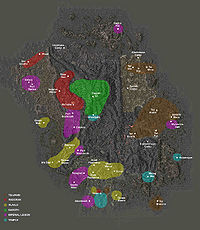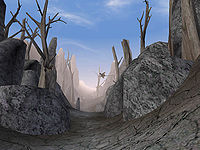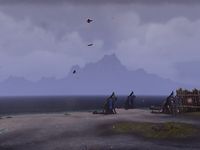Lore:Vvardenfell
| Esta página está sendo redesenhada para o Projeto de Lugares da Lore (LPP). A página pode precisar de algum trabalho para se encaixar em nossos padrões da página do projeto. |
| Para manter o padrão de qualidade do nosso site, este artigo ou seção pode precisar de limpeza. O usuário que colocou isto aqui teve a seguinte preocupação: make this more MW neutral and historical, history, short notes on eruption, Chimer/Dwemer Para deixar uma mensagem sobre a limpeza deste artigo, por favor adicione-a na página de discussão do mesmo. |
| Vvardenfell | |
|---|---|
| Type | Region |
| Continent | Tamriel |
| Province | Morrowind |
| Sub-regions | Ascadian Isles, Ashlands, Azura's Coast, Bitter Coast, Firemoth, Grazelands, Molag Amur, Red Mountain, Sheogorad, West Gash |
| Appears in | Morrowind |
A grande ilha de Vvardenfell se localiza dentro do mar Interno e é cercada quase completamente por Morrowind continental, exceto pelo norte, que encontra o Mar dos Fantasmas. É um dos seis Distritos Imperiais da província de Morrowind. Tal distrito é dominado pelo grande vulcão, a Montanha Vermelha. Caracterizado por desertos de cinzas, planaltos rochosos e regiões úmidas costeiras preenchidas por flaura e flora incomuns. Durante o Ano Vermelho de 4E 5, Vvardenfell foi destruída após a queda do Ministério da Verdade ao se chocar com a cidade de Vivec, causando a erupção da Montanha Vermelha. A maior parte da ilha ficou coberta em cinzas, forçando a evacuação da população.
History
Imperial Administration
Previously a Temple preserve under Imperial protection, Vvardenfell Territory was reorganized in 3E 414 as an Imperial Provincial District. Vvardenfell had been maintained as a preserve administrated by the Temple since the Treaty of the Armistice in 2E 896, and except for the independent Ashland tribes and a few Great House settlements sanctioned by the Temple, Vvardenfell was previously undeveloped. The region was host to large populations before the War of the First Council; few remained by the time of the reorganization, perhaps due to the Blight. When the centuries-old Temple ban on trade and settlement of Vvardenfell was revoked by King Llethan of Morrowind, a flood of Imperial colonists and Great House Dunmer came to Vvardenfell, expanding old settlements and building new ones.
The new District was divided into Redoran, Hlaalu, Telvanni, and Temple Districts, each separately administered by local House Councils or Temple Priesthoods, and all under the advice and consent of Vedam Dren and the District Council in Ebonheart.
The Red Year
In the absence of Vivec, the Ministry of Truth became unstable. The Dunmer Vuhon created a device known as The Ingenium that kept the Ministry of Truth floating over the city of Vivec by consuming souls. While only undesirables and criminals were originally used, eventually it used souls which could continue to feed the Ingenium without causing immediate death. When the Dunmer woman Ilzheven was taken to power the machine, her former lover Sul rescued her from the machine. This caused the Ministry of Truth to crash into the city of Vivec, which led to Red Mountain erupting. The eruption led to most of the island being covered in ash, leading to a mass exodus to the nearby island of Solstheim.
Politics
Following the Imperial reorganization, Vvardenfell was ruled by the Grand Council in Ebonheart, which consisted of representatives from the main powers present on Vvardenfell: The three Great Houses Hlaalu, Redoran and Telvanni, the Tribunal Temple, the Imperial Commission and the Imperial Magistrate. Duke Vedam Dren of House Hlaalu was the head of the council, representative of the Emperor and leader of the Vvardenfell district.
Local law became a mixture of House Law and Imperial Law in House Districts, jointly enforced by House guards and Legion guards, with Temple law and Imperial law enforced in the Temple district by Ordinators. The Temple was still recognized as the majority religion, but worship of the Nine Divines was protected by the legions and encouraged by Imperial cult missions.
Commerce
Imports and exports are tightly-controlled by the East Empire Company, which deals largely with Imperial-friendly House Hlaalu. The company mines raw ebony and glass on the island. It holds exclusive charters on these items and most other native commodities, such as local spirits and agricultural products. Outside these official channels, the Empire forbids the trading of moon sugar, skooma, and Dwemer artifacts. As such, smuggling is big business. Slavery is legal in Morrowind, and House Dres competes with smugglers to supply the market with forced labor.
Geography
Created by the last giant eruption of Red Mountain, Vvardenfell has several regions: Ascadian Isles, Ashlands, Azura's Coast, Bitter Coast, Grazelands, Molag Amur, Red Mountain, Sheogorad, West Gash and Zafirbel Bay. The central and southeastern regions are mountainous wastes regularly scoured by ash storms.
Foyada
Foyadas, or fire-rivers in the native Ashlander language, are deep, ash-dark ravines which run down from the Red Mountain volcano on Vvardenfell. The lava from Red Mountain is very fluid and runs almost like water. During an eruption, lava pours down the mountainside and leaves the area bare of all vegetation. Once a Foyada is created, the chance of a new one lessens, as the lava will normally run down the existing one. They are a good alternative to roads when heading towards the rugged mountain, as they have good footing, are clear of brush, and run for long distances.
Foyada Mamaea is one of the largest foyadas running down the slopes of Red Mountain. It runs from the southern lip of the crater of the volcano through Ghostgate, which is built in the center of the Foyada, then generally south-southwest, past Moonmoth Legion Fort before finally ending a bit east of Hla Oad.
Seven other foyadas exist on Vvardenfell: Foyada Ashur-Dan; Foyada Bani-Dad; Foyada Esannudan; Foyada Ilibaal; Foyada Nadanat; Foyada Zabirbael; and the lost Valley of the Wind.
Settlements
The biggest towns are Balmora, Vivec, Ald'ruhn and Sadrith Mora. Also on the island, various remains of distant times are found in form of Daedric Shrines, ancient Velothi Towers, Dwemer Ruins, and post-Velothi Dunmer Strongholds.
People
Native to Vvardenfell since the First Era are the dark-skinned, red-eyed Dunmer (known as the Chimer ages ago), which make about half of the population. The other half are divided roughly equally among the other nine races of Tamriel. Inhabitants of Vvardenfell include members of three of the five Great Houses, Velothi commoners, nomadic Ashlanders and members of the Tribunal Temple, to which all wilderness areas ostensibly belong. Outlanders are not particularly welcome, especially in Telvanni-controlled areas. The Imperial Legion and Imperial guilds are well established though and accept foreigners openly. House Hlaalu is also rather welcoming to them, as evidenced by their two non-Dunmer Councilors.
Dunmer inhabitants of Vvardenfell have a keenly-developed sense of identity, as they live in a sacred place that has been host to many of the defining moments in Dunmeri history. The common people regard themselves as servants of the Living Gods and the heirs of the Velothi movement. Saint Veloth is credited with bringing the Chimer and by extension, the Dunmer to their proper place in the world. Daedra worship has long-since fallen out of favor with most of the population, but it still holds a valued place in culture and tradition, as the Tribunal are regarded as either complementing or amicably replacing the worship of the Lords of Misrule.
Despite the decline in their worship, many species of Daedra, ranging from the bestial clannfear and daedroths to the sentient Dremora and Golden Saints, are a common sight on the island. These Daedra are usually found lurking among the ruins of Daedric shrines or in Vvardenfell's wilderness, and tend to attack approaching mortals on sight. Summoned Daedra were also utilized by the Temple for ritualistic purposes, and by high-ranking members of the Great Houses (particularly of House Telvanni) as security.
Central to the psyche of the Vvardenfell Dunmer is Red Mountain, whose geography and silhouette dominates the region. Constant storms dictate the course of everyday life and give the different environments their distinctive characters. The volcano also keeps the island in a constant state of flux, as evidenced by old maps showing the entire island made up of Ashlands, lava rivers running to the sea, and accounts of ash falling onto the streets of the city of Vivec.
Transportation
Inhabitants of Vvardenfell rely on beasts of burden, such as Guar or Silt Striders (giant insects), or make use of various seagoing vessels to transport people and cargo. Guild Guides provided by the Mages Guild can also provide transportation.
Religion
Traditionally Ancestor and Daedra worshippers, the people here now have two main religions, the Imperial Cult of the Nine Divines and the Tribunal Temple, who worship the Almsivi. Additionally, the Ashlanders have their Nerevarine Cult, as well as the older Velothi beliefs (ancestor and Daedra worship). The Temple's Ordinators traditionally outlaw and persecute religious sects other than their own, but the Imperial presence has brought a certain amount of freedom of religion; nevertheless, religions deemed damaging to the Empire are unprotected and the Ordinators pursue their members mercilessly. Cults devoted to the House of Troubles, despite being banned by the Temple, have drawn a cosmopolitan following in the wilderness regions.
Notes
- While not accessible, Vvardenfell and Red Mountain are clearly visible in the Dragonborn expansion for TES V: Skyrim.
See Also
- For more information, see the Morrowind Vvardenfell article.


